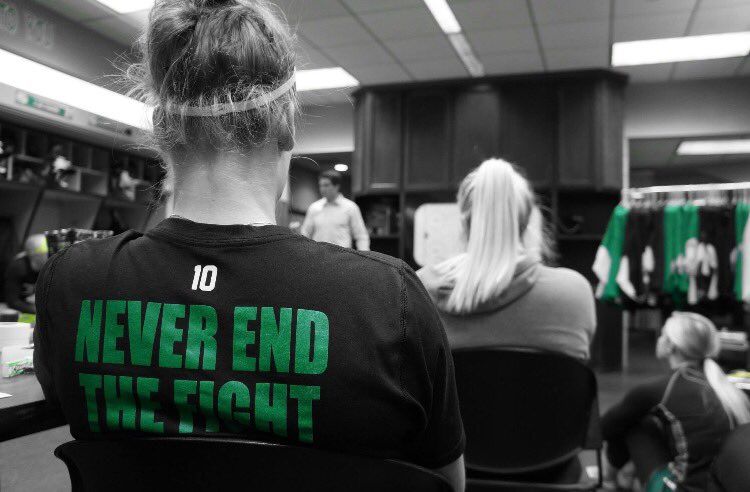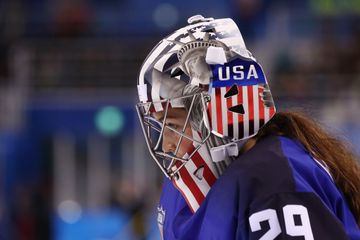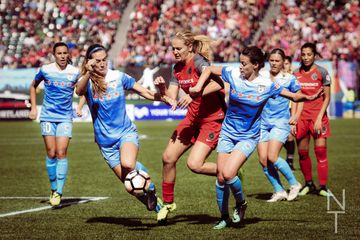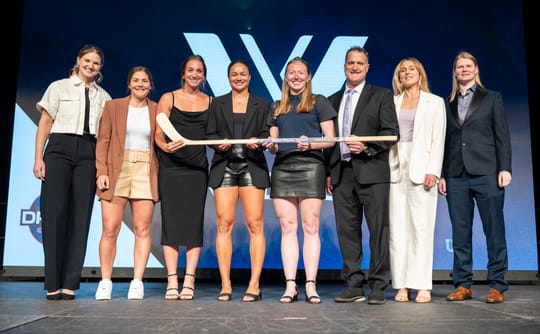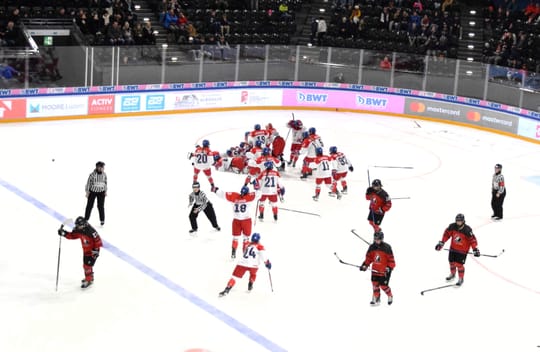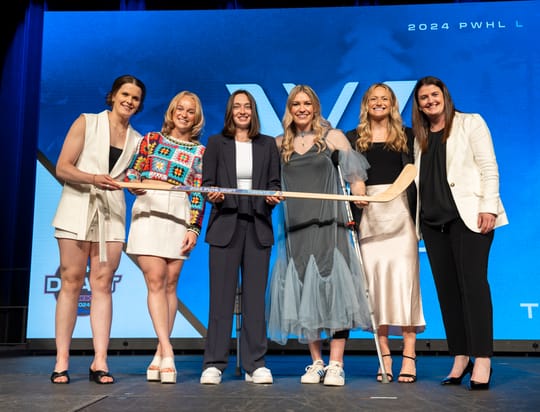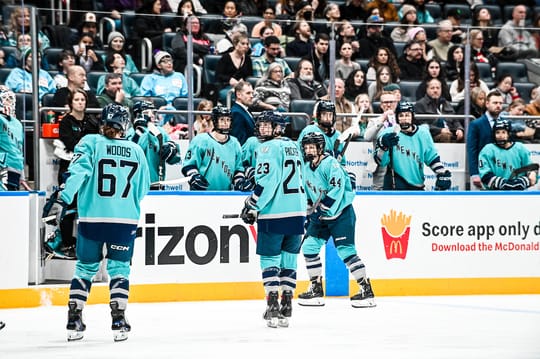Players with remaining NCAA eligibility were on the ice for practice on March 29, 2017 when news began trickling in that the University of North Dakota was unceremoniously dropping its women's hockey program. Now, they're taking to the courts.
Attorney Dan Siegel says he was first contacted by a former UND player in March of this year, shortly after representing renowned coach Shannon Miller in her groundbreaking sex discrimination and retaliation suit against the University of Minnesota Duluth. At least two complaints -- both of which were dismissed last fall due to a lack of evidence -- had been submitted to the Office for Civil Rights shortly after the program cuts were announced, but no legal action had previously been taken.
"Representing Shannon Miller and getting to know a lot of her players at UMD made me appreciate the accomplishments of the young women who are playing, as well as their enthusiasm and skill at the sport," Siegel explained. "Of course, UMD's always been compared to North Dakota, Minnesota, and Wisconsin, and for good reason. It seemed like a very bizarre and strange development and I was quite interested in pursuing it once I was contacted."
On June 12, 2018, a complaint was filed in United States District Court by eleven former UND women's hockey players who had two or more remaining years of NCAA eligibility at the time of the cut; they are seeking class status to represent current, prospective, and future female students who are harmed by the program's elimination. They allege that, in cutting its women's hockey program, UND violated their rights under Title IX. Unlike most similar cases to date, though, this complaint takes a legal approach that does not rely on the widely-publicized three-prong test for athletic participation opportunities, which only requires institutions to meet any one of three standards for compliance. If successful, the precedent set by this line of argument could change the landscape of NCAA hockey.
Legal Background
In 1979, the Department of Health, Education and Welfare of the Office for Civil Rights published A Policy Interpretation: Title IX and Intercollegiate Athletics. This policy interpretation was legally mandated to clarify the factors that would be considered by the Department of Education in evaluating compliance with Sections 106.37 and 106.41 of the Title IX Regulation, which are the primary sections that apply to athletics. While the policy interpretation is not technically law, it must be accorded a "particularly high" degree of deference by the courts, and thus holds considerable weight.[1] (This clear, well-structured summary of the policy interpretation is a useful resource, and a helpful companion to the rest of this piece.)
The policy interpretation is divided into three main sections: Athletic Financial Assistance (Scholarships), Equivalence in Other Athletic Benefits and Opportunities, and Effective Accommodation of Student Interests and Abilities. The argument in the UND players' complaint focuses primarily on the third section, which itself contains three subsections:
- the determination of athletic interests and abilities of students
- the selection of sports offered
- the levels of competition available including the opportunity for team competition
It is under this third subsection, Levels of Competition, that the three-prong test is included. The test is meant to assess whether institutions "effectively accommodat[e] the interests and abilities of male and female athletes [by providing] both the opportunity for individuals of each sex to participate in intercollegiate competition, and for athletes of each sex to have competitive team schedules which equally reflect their abilities." (Editor's note: "each sex" is the language used in the policy; the Victory Press acknowledges a much wider degree of variance in gender and sex.)
Three-Prong Test
a. Compliance will be assessed in any one of the following ways:
(1) Whether intercollegiate level participation opportunities for male and female students are provided in numbers substantially proportionate to their respective enrollments; or
(2) Where the members of one sex have been and are underrepresented among intercollegiate athletes, whether the institution can show a history and continuing practice of program expansion which is demonstrably responsive to the developing interest and abilities of the members of that sex; or
(3) Where the members of one sex are underrepresented among intercollegiate athletes, and the institution cannot show a continuing practice of program expansion such as that cited above, whether it can be demonstrated that the interests and abilities of the members of that sex have been fully and effectively accommodated by the present program.
Most discussion around Title IX compliance in athletics centres this three-prong test, likely because most cases, historically, have involved a clear substantial disparity between female enrolment and athletic participation opportunities. As such, many people tend to think of the three-prong test as the only measure of Title IX compliance in college sports -- it doesn't help that the NCAA's own Title IX FAQ focuses on it. Within the three-prong test, the interests and abilities of women are only considered if their institution cannot meet the criteria of the first prong; an institution with substantially proportionate numbers needn't worry about them.
Substantially Proportionate Participation Opportunities
The complaint against UND does contend that the University improperly calculated athletic participation rates, so there is the potential for a successful argument within the three-prong test. UND claims that they have provided for substantially proportionate participation; the allegations to the contrary involve proving that the University has misrepresented roster numbers, so the burden of proof may be difficult to fulfill.
The University of North Dakota reports that its 2016-17 enrollment figures were 8787 full-time undergraduate students, of whom 53.82% were men and 46.18% were women. Its reported total athletics participation rate in that year, minus four men who were counted on the women's basketball roster as members of the practice squad, was 49.53% men and 50.47% women. The total sports participation rate for 2016-17, excluding the three programs that were cut at the end of the year and the four male basketball players, would equal to 53.02% men and 46.98% women. According to these figures, then, UND had an overrepresentation of female athletic participation compared to enrollment prior to the cuts, and could project substantially proportionate participation after the cuts.
The unduplicated figures, post-cuts, have athletics participation at 55.49% men and just 44.51% women, a disparity of 1.67% compared to enrollment, which is likely not substantial enough to be deemed non-compliant.[2] Whether multi-sport athletes should indeed be counted multiple times would depend on the specific circumstances of their participation.[3] In any case, UND's alleged overreporting of the number of female athletes would have to be at a fairly large scale if the players are to prove a substantial disparity.
Beyond Three Prongs
Under the policy interpretation, Levels of Competition, Selection of Sports, and Determination of Athletic Interests and Abilities are three separate subsections. The three-prong test to measure compliance under Levels of Competition, then, shouldn't override the evaluation criteria under the other two subsections. It may seem straightforward from the text of the policy, but it's an approach that has seemingly never been used before in a court of law.
"I believe that it's relatively new [as a legal argument]; I'm not aware of cases that arise from similar fact patterns to what we have here," said Siegel, noting that this case deals with the elimination of an existing team in the context of a sport that is both popular and growing, particularly within the region. "That [growth and popularity] is the kind of development which I believe the policy advice recognizes."
The players' complaint invokes all three subsections, but it's the assessment criteria under Selection of Sports that are perhaps the most compelling. The policy interpretation states that institutions aren't inherently required to sponsor the same exact sports for men and women, but that they may be required to sponsor a team under certain conditions, depending on whether the sport is considered contact or non-contact. Ice hockey is, unsurprisingly, a contact sport.
Effective accommodation means that if an institution sponsors a team for members of one sex in a contact sport, it must do so for members of the other sex under the following circumstances:
(1) The opportunities for members of the excluded sex have historically been limited; and
(2) There is sufficient interest and ability among the members of the excluded sex to sustain a viable team and a reasonable expectation of intercollegiate competition for that team.
The University of North Dakota sponsors a men's ice hockey team. The opportunities for women in ice hockey have historically been limited -- while UND's men's team was launched in 1929, the women's team debuted in 2002. At the time of the cut, the University of North Dakota had an entire roster and recruiting class of women who were both interested and able to sustain not just a team, but a nationally-ranked team competing in the WCHA, the toughest women's hockey conference in the country. It seems clear that the circumstances of this case would, according to these criteria, require UND to sponsor a women's ice hockey team in order to meet the standard of effective accommodation.
Potential Implications
The most difficult part of making the Selection of Sports argument will likely be ensuring that it's considered independently of the three-prong test. All mentions of effective accommodation in the relevant case law are in the context of the third prong; none have attempted to argue for it outside of the three-prong context.
Proving that UND does not, in fact, offer substantially proportionate participation opportunities according to the three-prong test would be a victory, though that still may not ensure that the women's hockey team, specifically, is restored.
But if the players are successful in their Selection of Sports argument, the precedent this case sets could be phenomenal.
"I think that if we are successful, number one, this won't happen again -- certainly at a Division I school that has a women's ice hockey program," Siegel said. "Secondly, if there are schools that are considering implementing programs where they did not previously exist, I think it would recommend very strong advice to those schools that if they decide to bring on men's ice hockey, they've got to bring on women's ice hockey, too."
The NHL recently began undertaking feasibility studies on the expansion of NCAA Division I men's hockey, most notably with the University of Illinois. An athletics department spokesperson told the Chicago Tribune in March that if men's hockey is added, a women's hockey team would "be one of several options but not necessarily the end result" in terms of ensuring the school complies with Title IX.
When it comes to participation opportunities, that's all well and good. But if enough female students demonstrate interest and ability in ice hockey, and make a compelling case about the interest of potential recruits, they could have a strong argument under the Selection of Sports section of the policy.
If the UND players use this argument successfully and their case becomes legal precedent, it would make it difficult for schools to justify instituting new men's programs without also adding corresponding women's teams -- and this could apply not just to ice hockey, but to any contact sport.
Next Steps
After the complaint has been served (at the time of writing, it has not), UND will have 21 days to file an answer. They can simply respond by denying the allegations (this is the most common way for suits to proceed) or they can file a motion for dismissal, contending that the players have not presented a viable legal claim.
"I'm very confident that we have stated a legal claim," said Siegel. "So even if they ultimately succeed in beating us, they will beat us on [the merits of] a legal claim that we've articulated."
If that legal claim succeeds, it could change the game for women's contact sports throughout the NCAA and beyond.
(Photo credit: Kristen Campbell/Twitter)
